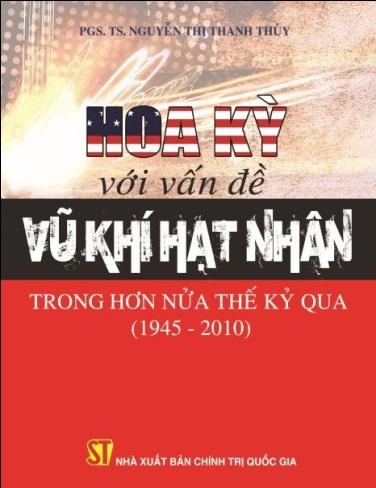USSH introduces the book "The United States and the nuclear weapons issue over the past half century (1945-2010)" by Associate Professor, Dr. Nguyen Thi Thanh Thuy (Faculty of International Studies, University of Social Sciences and Humanities), National Political Publishing House - Truth, October 2012, 344 pages.
Nuclear weapons and nuclear arms reduction have been important political and military issues since World War II. As the first country to successfully manufacture nuclear weapons and the first to use them in war, the United States has used them as an effective tool in its foreign policy.

Along with the nuclear arms race, from the beginning the United States was aware of the vital issue of controlling the proliferation of nuclear weapons in order to maintain its monopoly and advantage in international affairs. However, in 1949 the Soviet Union broke the monopoly of the United States, becoming the second country to possess this dangerous weapon. Then a series of countries such as England, France, China, ... produced nuclear weapons. In the context of the Cold War, the issue of nuclear weapons, especially the nuclear arms race between the superpowers, mainly between the United States and the Soviet Union, pushed the world to the brink of destruction. The issue of disarmament was urgently raised and the United States became a pioneer in the process of controlling and reducing nuclear weapons. The question is why, so early, did the US administrations make proposals on controlling and limiting nuclear weapons? What was the main motive of the United States in this issue? etc. To help scientists, military experts and a wide range of readers interested in and learning about nuclear weapons, the National Political Publishing House - Truth published the book "The United States and the nuclear weapons issue over the past half century (1945-2010)" by Associate Professor, Dr. Nguyen Thi Thanh Thuy (Faculty of International Studies). The book provides basic information on the issue of nuclear weapons in particular and weapons of mass destruction in general. On that basis, the author focuses on discussing the following issues: 1. The motives and role of the United States in the process of controlling and reducing nuclear weapons; 2. The significance of the treaties on controlling and reducing nuclear weapons that the United States has signed for world peace and security. In addition, the book also mentions the movement against the arms race and against nuclear weapons in the world; Vietnam's viewpoints and policies on the issue of nuclear weapons and nuclear technology.
National Political Publishing House - Truth
The book consists of 4 chapters with the following main contents: Chapter 1: The basis of the process of controlling and reducing nuclear weapons (1945-1962). This chapter presents the background of the birth of nuclear weapons, the US's motives for dropping atomic bombs on Japan in 1945 and its consequences. Some other issues related to nuclear weapons presented in this chapter include the views of the American people and the US government on nuclear weapons, the beginning of the nuclear arms race between the United States and the Soviet Union, the Cuban missile crisis in October 1962 and its consequences, the initial negotiations between the United States and the Soviet Union on the issue of controlling and reducing nuclear weapons. Chapter 2: The United States and the issue of controlling and limiting nuclear weapons (1963-1976). This chapter analyzes the international context, the current state of nuclear weapons proliferation in the world as well as the correlation of nuclear weapons forces between the United States and the Soviet Union. These are important bases for planning and implementing foreign policy and nuclear policy of the US administrations. During this period, the United States signed five bilateral and multilateral treaties on nuclear weapons control and limitation. The author analyzed the motives of the United States in participating in these documents as well as the impacts of those documents on international relations and US-Soviet relations. Chapter 3: The United States and the issue of reducing strategic nuclear weapons (1977-1991). Chapter 3 presents the foreign policy and nuclear policy of the US administrations during this period related to international relations, US-Soviet relations, and the nuclear arms race in the world. This chapter also presents the signing of three important treaties on strategic nuclear arms reduction between the United States and the Soviet Union, analyzing the significance and impacts of these documents on international political life, especially in Europe. Chapter 4: The United States and the nuclear weapons issue after the Cold War (1992-2010). This chapter focuses on presenting the nuclear policies of the US administrations under Presidents Bill Clinton, George Bush, and Barack Obama in the context of the international security and political situation after the Cold War. The role of the United States in the nuclear crises of North Korea and Iran, and the movement against the nuclear arms race in the world during this period are also the main contents of Chapter 4.

